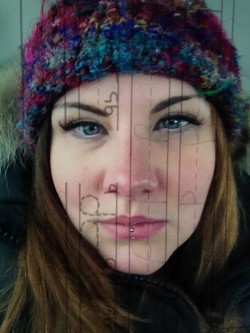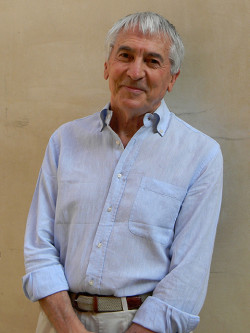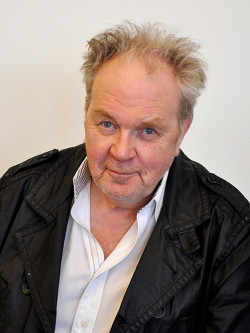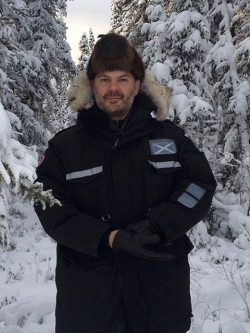Counterpoints is a panel discussion on Thursday May 21, from 5:00 to 6:15pm in 2–20 Fine Arts Building at the University of Alberta. Audience members are invited to ask questions. View the video on the Counterpoints page.
Our panelists are Courtney Chetwynd, Jorge Frascara, Richard Isaac and Gavin Renwick.
 Courtney Chetwynd
Courtney Chetwynd
Biography
Courtney Chetwynd is an artist-researcher who was raised in the Eastern and Western Arctic of Canada’s Northwest Territories. Currently a Ph.D. Candidate with the University of Dundee in Scotland, her work explores concepts of performativity and liminiality within Northern culture, through placed based research and interdisciplinary artistic practice. Courtney holds a Bachelor of Fine Arts degree from Mount Allison University and a Master of Fine Art degree from the University of Calgary. She has exhibited work in New York City, Atlanta, Indianapolis, Scotland, throughout Canada, and most recently, in London, UK. Courtney has received awards and research grants from the Alberta Foundation of the Arts, the Banff Centre for the Arts, the Canada Council for the Arts, the University of Calgary, the Centre for Research in the Fine Arts, and the NWT Arts Council. Her work focuses upon themes and metaphors of the body, space, and relationships by integrating Northern concepts and materials in a poetic and psychologically charged manner.
Research Interests
My research concerns attempt to uncover how visually based methods can work to reveal what larger society renders invisible. The investigation into areas of performativity, the liminal, the socially mediated body and culturally produced sites of transformation is undoubtedly a challenge to research and potentially difficult to articulate in a strictly Western sense- through traditional academic methods. The common crux related to hierarchies of knowledge is avoided through tracing its continuum, plurality rather then polarization. Such a framework aims to honor local and Traditional Knowledge and its real and tangible impact towards framing complex problems, as well as exploring extended roles for the artist-researcher in society.
I am interested in developing a framework of methods that have the potential to serve for other how other researchers and artists might endeavor to direct their own experience through practice, and incorporates increasingly intimate ways of knowing within the research process. More importantly, the potential lies in how place, people, and environment can direct this process in an evolutionary way.
I consider how visual research and the role of the artist-researcher can assist in the expression and discovery of this knowledge. My research inquiry centers upon the construction of identity and memory as a spatial process that is not only physical but should be investigated through the ‘invisible’ found within the performative and common nature of action, images, and stories. I am concerned with how these things are inscribed socially and historically. Why has their purpose and context changed? And what are the possibilities for discovering these new forms of knowledge?
Response to Design Latitudes Themes
an/other north: considering the role of tacit knowledge in the North
By Courtney Chetwynd
“We are confronted with fallacies of the north as a binary opposition. There are the media representations of the imaginary north as an uninhabited beauty. An idea that this is land is a well of untapped riches to be exploited and emptied. I see extreme adventure travelers arrive each summer and winter outfitted in the finest Northface and Canada Goose gear to tackle the “final frontier”, and researchers from the south here for short periods of time whose feet touch the ground just long enough to conduct random research projects that often have little importance or use here. Visitors take what they need and then leave, filled up with stories and images of the strange idiosyncrasy here in the North, smug for having participated in a temporal ‘charting’ of their own piece of the North…”
Read more by Courtney Chetwynd.
 Jorge Frascara
Jorge Frascara
Biography
Jorge Frascara is Professor Emeritus of the University of Alberta, Honorary Professor at Emily Carr University, Fellow of the Society of Graphic Designers of Canada, and member of the editorial boards of the Information Design Journal, Visible Language and Design Issues. He has held leading positions at the University of Alberta, Icograda, the ISO, the Society of Graphic Designers of Canada, and the Graphic Design Education Association (USA), and has been advisor to the ISO and to the Canadian Standards Council regarding graphic symbols. He has published ten books and more than 60 articles internationally, and has lectured and made presentations in more than twenty-five countries. Past clients include the Government of Canada, the Government of Alberta, the Mission Possible Coalition (traffic safety), the Alberta Drug Utilization Program, and the Health System in Italy. He lives in Vancouver, consulting on information design for the health sector with his wife, Guillermina Noël.
Research Interests
Perception and comprehension of visually presented information; Public health and safety communications strategies and campaigns; Research and design methods to work in a user-centred, evidence-based and results-oriented approach to designing; Visual communications and design as value-loaded culture builders.
Response to Design Latitudes Themes
Design Latitudes: some questions to think about
By Jorge Frascara
“Further to the provocations published in the website, and the request for responses to the themes, I became inclined to prepare this that follows as a set of questions rather than as a set of statements. Here they go…
In what way you think that “the North” could be different from other places regarding design education? (Is the climate a determinant? Is the history? Are the people? Is it the economic level? Does religion and other cultural traditions have any role to play? Are there other factors that affect the whole context?)
What are the essential universal components of good design?
(Is there such a thing? Or does design change so much from region to region and from project to project that there is no way to find constant characteristics? Can one even want to find them? If so, why?)…”
Read more from Jorge Frascara.
 Richard Isaac
Richard Isaac
Biography
Richard was born and educated in England and studied Architecture at the Oxford School of Architecture (now known as Oxford Brookes University), graduating in 1976. He came to Canada in 1982 and worked for three years as a volunteer in the First Nation community of Wabasca in Northern Alberta. In 1987, he began work with Vivian Manasc in the architectural firm FSC Groves Hodgson Manasc – the pair then founded their own practice, Manasc Isaac Architects Ltd., in 1997.
At Manasc Isaac Architects, Richard is the Principal-in-Charge of Design and Projects. In this role, he is responsible for overseeing a number of the firm’s key projects. For Richard, there are no template solutions to design challenges. Of paramount importance to Richard is the design of buildings, which will have zero impact on the environment through an integrated design process. The sustainable building is architecture’s gift to the global ecology.
Research Interests
Not being an academic, I cannot say that I have any areas of “research” as such. But my interest and passion outside the daily demands of the business of architecture, is Biomimicry. I am fascinated by the potential of learning from and then mimicking biological processes: for example how fur of animals adapt to various temperatures to provide “insulation”, paint developed from the lotus flower that is self cleaning, how Zambian Termites build very tall mounds in the desert and control temperature by constantly opening and closing heating and cooling vents. There is an ever-increasing encyclopedia of examples, which I want to introduce in my design work.
Response to Design Latitudes Themes
The North as a challenge to designing good buildings
By Richard Isaac
“Up to now, the architectural design community at large has not fully investigated nor examined the potential of good design solutions for the Canadian North. The buildings we have been attempting to design in the Canadian North have only partially met the physical needs of the users of the buildings…”
 Gavin Renwick
Gavin Renwick
Biography
For over 25 years Gavin Renwick has taught in and worked through architecture, design, fine art and curation. His undergraduate study was in Interior Design at Napier College, Edinburgh; his M.A. undertaken at the Royal College of Art, London (supported by the prestigious Darwin Scholarship). The University of Dundee was the base for his doctorate studies, resulting in the thesis “Spatial Determination in the Canadian North: A Theoretical Overview and Practice-Based Response,” one of the first practice-based PhD’s submitted in the UK. This was directly followed by a three year UK Arts & Humanities Research Board Fellowship in the Creative and Performing Arts. In 2005 Renwick was appointed Professor and Chair of Art & Policy at Duncan of Jordanstone College of Art & Design, University of Dundee. Gavin has realized projects across Europe, as well as in Turkey and Canada. He joined the University of Alberta in 2010 as the first Canada Research Chair for Design Studies in the country.
Research Interests
Visual Thinking and Communication; Participatory Design; Practice-based Research and Research Creation; Sustainable Design; Cold Climate Design; Inter-Disciplinarity; Post-Colonial Aesthetics; Visual Culture; Indigenous Cultural Policy; Parity between Indigenous and Euro-Canadian Knowledge; Circumpolar Studies; The Role of Art, Design and Architecture in Cultural and Political Self-Determination.
Response to Design Latitudes Themes
Assimilation, though Design
By Gavin T. Renwick
“The diverse cultures of the north have also had to deal with modernisations presumption of ‘mastery’ on many levels, including constructing a stereotype ‘traditional’ society through which indigenous identity, knowledge, and scholarship could be covertly debased and overtly assimilated. However, the complexities within arctic ecosystems and the perceivably empty landscape (at least to the Euro-Canadian eye), starkly and literally evidences how imposed developmental strategies and design processes are in rude contradiction to the supposed intention of ‘improvement’…”
